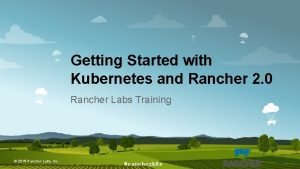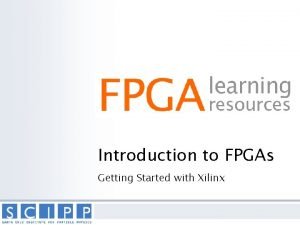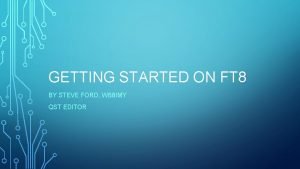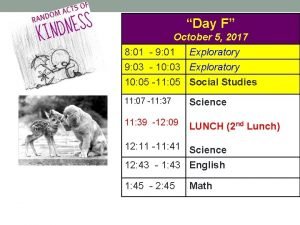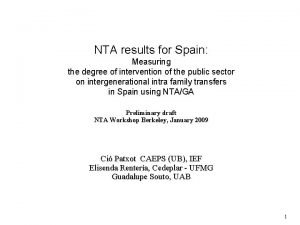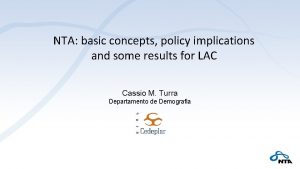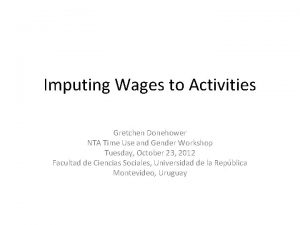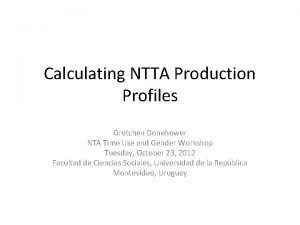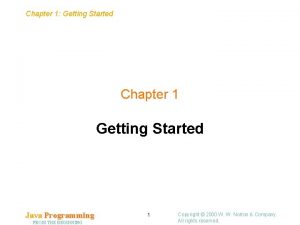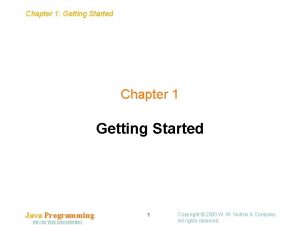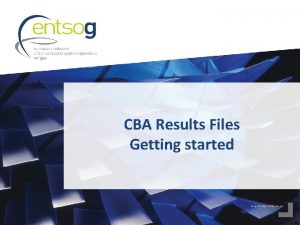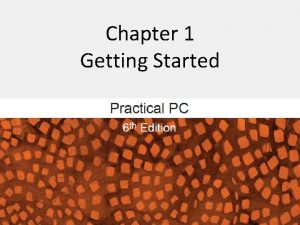Track A NTA Orientation and Getting Started Gretchen

































- Slides: 33

Track A: NTA Orientation and Getting Started Gretchen Donehower The Tenth Meeting of Working Group on Macroeconomic Aspects of Intergenerational Transfer Beijing, China Monday, November 10, 2014

Outline 1 Preliminaries 2 NTA motivation and goals 3 NTA features and organization 4 Data and basic methods 5 Steps to complete NTA 6 Extensions to “Basic” NTA 7 Lab exercise

Outline 1 Preliminaries 2 NTA motivation and goals 3 NTA features and organization 4 Data and basic methods 5 Steps to complete NTA 6 Extensions to “Basic” NTA 7 Lab exercise

1 Preliminaries • Workshop objectives – Understand NTA project and estimates – Get started on macro controls and age profiles • Introductions – Who are you? – What are your NTA objectives? – Tell us about your data, what you have, what you need to find • Population counts • National accounts • Household surveys and administrative records

1 Preliminaries • Does everyone have access to the NTA wiki? (www. ntaccounts. org) • Resources to learn more on the NTA wiki – NTA “course” – Link to NTA manual – Link to 2012 comparative volume

Outline 1 Preliminaries 2 NTA motivation and goals 3 NTA features and organization 4 Data and basic methods 5 Steps to complete NTA 6 Extensions to “Basic” NTA 7 Lab exercise

2 NTA Motivation and Goals • Measuring the generational economy – How we produce, consume, share, and save resources by age – Research network of teams in over 40 countries • Motivating questions – How do changes in population age structure impact economies and economic growth? – How does economic life vary by age? – How does the intergenerational economic system affect the economy and prospects for growth?

NTA Example – Economic lifecycle Working-age lifecycle surplus Young-age lifecycle deficit Old-age lifecycle deficit

NTA Example – Reallocations

Example of change over time (US total consumption) In units of average labor income, ages 30 -49

2 NTA Motivation and Goals • What do we learn from NTA? – Are our support systems sustainable? – Does the generational economy impact economic growth? – Changing age patterns? • Example: demographic dividends – First DD: age structures favorable to production – Second DD: age structures favorable to capital • Fertility decline associated with greater HK investment per child • Older populations concentrated in ages with more assets which can be invested to increase the K/L ratio

Outline 1 Preliminaries 2 NTA motivation and goals 3 NTA features and organization 4 Data and basic methods 5 Steps to complete NTA 6 Extensions to “Basic” NTA 7 Lab exercise

3 NTA features and organization • What is an age profile? – A schedule of age-specific average flow amounts – Based on flow measure or proxy indicator from • • a household survey a government report other NTA age profiles NTA assumptions – Smoothed over age – Adjusted up or down so that aggregate flow matches an aggregate estimate from national accounts

3 NTA features and organization • NTA age profiles disaggregate national accounts by age – Now focused on flow account; will eventually include asset revaluation and wealth accounts • NTA is generally consistent with the System of National Accounts (SNA) except: – SNA tracks by sector (corporate, gov’t, household) but NTA is always from the individual perspective • Government, corporate, and household flows imputed to the individuals who “own” those institutions – SNA does not include intra-household transfers, that is an innovation of NTA – Some changes in SNA aggregates

The Flow Account Identity • Inflows – Labor Income – Asset Income – Transfer Inflows • Outflows – Consumption – Saving – Transfer Outflows

3 NTA features and organization • Reallocations are classified by economic-form and mediating institution:

3 NTA features and organization • Asset-based reallocations allow for intertemporal exchange – Save now, spend later – Go into debt and spend now, repay later – Invest now, spend flow of returns in future • Transfers involve no explicit quid pro quo – May involve implicit obligation, e. g. , transfers between children and parents – Transfers must balance (inflows = outflows), but may also include net transfers to or from Rest-of. World

Organization of Accounts Transfers have inflows and outflows. Also collect a full set of tax profiles.

Outline 1 Preliminaries 2 NTA motivation and goals 3 NTA features and organization 4 Data and basic methods 5 Steps to complete NTA 6 Extensions to “Basic” NTA 7 Lab exercise

4 Data and basic methods • Data: population, national accounts, household surveys, administrative data 1. Population estimates - Single year of age to 90+ - Evaluated for quality - Can use UN World Population Prospects if problems with national estimates - Significant non-household population?

4 Data and basic methods 2. National accounts data (in SNA format) - List of main SNA tables given in the manual, need tables by sector - Which government agencies produce your accounts? How do they publish the results? What is available in international databases? - Will probably also need: – government expenditure records – entries for your country in the International Monetary Fund’s Government Finance Statistics (GFS) publications

4 Data and basic methods 3. Household surveys - Income and expenditure surveys give direct measures or indicators of relative age patterns - May need to supplement with specialized surveys (older people, institutionalized population) 4. Administrative data - Government reports on public program participation by age - May give monetary flows - May only have participation indicators

4 Data and basic methods • Necessary features of household surveys and administrative records: – Nationally representative – Designated household head/householder – Sufficient sample size – Household roster by age, sex, work/school status – Includes necessary indicators: • Income by source (including work, government benefits, gifts, interest and dividend income, etc. ) • Expenditure by type (amounts paid for consumption, taxes, gifts, etc. )

How to calculate an age profile 1. Calculate the macro control from national accounts 2. Identify a measure or proxy indicator for the flow 1. From household survey – Use individual-level data if available – Otherwise allocate household amount to individuals in the household 2. From administrative records 3. On a priori grounds (i. e. assumed or calculated from other age profiles) 3. Calculate single-year age group averages • May have to adjust for any missing populations (i. e. persons not represented in survey or administrative records) 4. Smooth • Evaluate to ensure that no real variation has been eliminated 5. Adjust to controls • Evaluate adjustment factor to test the validity of the age shape

4 Data and basic methods • Smoothing: • Reduces noise from sampling • Smooth lowest-level components only • Beware of eliminating “real” features of the age pattern – Peaks/valleys, elbows, zeros • False negative values should be replaced with zeros • Details and examples in manual appendix

Outline 1 Preliminaries 2 NTA motivation and goals 3 NTA features and organization 4 Data and basic methods 5 Steps to complete NTA 6 Extensions to “Basic” NTA 7 Lab exercise

5 Steps to complete NTA Gather Data Lifecycle Accounts • Identify available surveys, administrative records, national accounts, and population data • Choose base year in which all necessary data are available • Obtain data permissions and copies of datasets • Evaluate data quality, coverage, usability • Calculate macro controls for components of consumption and labor income (some teams prefer to calculate all macro controls at this stage) • Estimate age patterns from administrative and survey data • Smooth, adjust to controls, and evaluate

5 Steps to complete NTA Public Age Realloc. Private Age Realloc. • Calculate macro controls for public reallocations (taxes, transfers, asset income, and saving) • Estimate age shapes for these variables from administrative and survey data • Smooth, adjust to controls, and evaluate • Calculate macro controls for private reallocations (transfers, asset income, and saving) • Estimate age shapes for inter-household transfers, asset income, and saving from survey data • Smooth, adjust to controls, and evaluate • Estimate components of intra-household transfers from already estimated profiles and sharing algorithm • Smooth, adjust to modified controls, and evaluate • Estimate private saving as the balancing item

5 Steps to complete NTA • Review and evaluate all estimates – See manual for list of checks • Document estimates on the wiki • Upload data and documentation in the wiki database

Outline 1 Preliminaries 2 NTA motivation and goals 3 NTA features and organization 4 Data and basic methods 5 Steps to complete NTA 6 Extensions to “Basic” NTA 7 Lab exercise

6 Extensions to “Basic” NTA • Further disaggregate NTA age profiles by other characteristics – Socioeconomic status – Gender – Geography (region, urban-rural, etc. ) • • National Time Transfer Accounts Wealth accounts Bequests Policy-relevant analyses and indicators

Outline 1 Preliminaries 2 NTA motivation and goals 3 NTA features and organization 4 Data and basic methods 5 Steps to complete NTA 6 Extensions to “Basic” NTA 7 Lab exercise

7 Lab exercise • Read country profile questionnaire – Any questions you do not understand? Ask! – Any items you do not know? – Any data you may not be able to get? • Work through simplified example of calculating a few age profiles – You can use the provided example data, or try to use your own and modify the code as necessary – Macro controls are given, you will learn more about how to calculate them for your country this afternoon
 Getting ahead
Getting ahead Getting started with vivado
Getting started with vivado Getting started with unix
Getting started with unix Splunk free training
Splunk free training Rancher getting started
Rancher getting started Getting started with excel
Getting started with excel Getting started with microsoft outlook learning
Getting started with microsoft outlook learning Getting started with xilinx fpga
Getting started with xilinx fpga Getting started with lua
Getting started with lua Unit 1 my hobbies
Unit 1 my hobbies Unit 1 local environment
Unit 1 local environment Find these things in unit 1
Find these things in unit 1 Infuecers gone wild
Infuecers gone wild Getting started with vivado
Getting started with vivado Perl getting started
Perl getting started Getting started with ft8
Getting started with ft8 Listen and read unit 3
Listen and read unit 3 Unit 1 getting started
Unit 1 getting started Getting started with poll everywhere
Getting started with poll everywhere Android development getting started
Android development getting started Tipos de habilidades del pensamiento
Tipos de habilidades del pensamiento Getting started with eclipse
Getting started with eclipse Mathematica getting started
Mathematica getting started The speedy fast ski resort has started to keep track
The speedy fast ski resort has started to keep track Nta ischemica
Nta ischemica Intertp
Intertp Ntaconcepts
Ntaconcepts Nta ireland
Nta ireland Nta location
Nta location Nta asia
Nta asia Ni-nta affinity chromatography
Ni-nta affinity chromatography Cell harvest
Cell harvest Raymond's run text dependent questions and answers
Raymond's run text dependent questions and answers Ethnocentric polycentric regiocentric and geocentric
Ethnocentric polycentric regiocentric and geocentric




